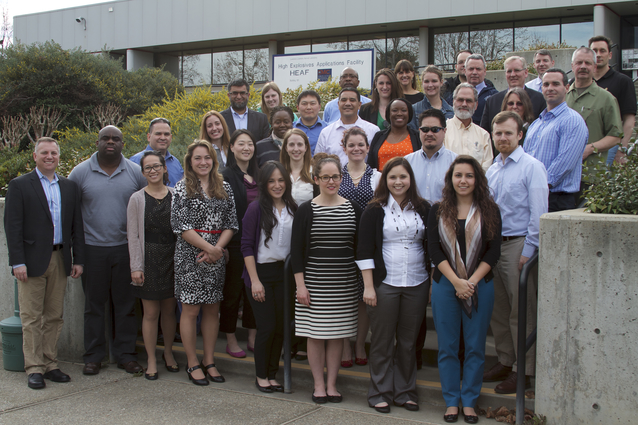Georgetown students study emergency and disaster management at Lawrence Livermore
Georgetown's newly created masters degree program is a collaboration between the university and LLNL. The yearlong program has 29 students who are taught in a cohort-style structure, with classes being held online as well as in four field study locations: Washington D.C., New Orleans, Lawrence Livermore and Doha, Qatar.
"The program is designed to prepare students for careers in emergency and disaster management and to become thought leaders in the field," said Nancy Suski, a senior staff member in the LLNL Office of the Deputy Director for Science & Technology who helped create the Georgetown program and serves as its executive director.
As one of the program's field learning sites, Lawrence Livermore hosted the students from Feb. 24 to March 1. During the trip, the students attended classroom lectures at the High Performance Computing Innovation Center (HPCIC ) on the Livermore Valley Open Campus (LVOC ) that included visualizations of chemical, biological, radiological and nuclear (CBRN) release scenarios developed by LLNL; visited facilities at LLNL and Sandia National Laboratories; heard guest speakers from LLNL and elsewhere; and participated in facilitated table top exercises focused on response and recovery from a biological and radiological release.
Some of the places they visited included: the National Atmospheric Release Advisory Center (NARAC ), High Explosives Application Facility (HEAF ), Forensic Science Center, National Ignition Facility (NIF ) and LLNL/Alameda County Fire Station. Students also participated in demonstrations of equipment used in the National Nuclear Security Administration (NNSA) Radiological Assistance Program and experienced the "Virtual Trainer," an advanced training tool developed by LLNL researchers.
Discussion topics included: defense support to civil authorities, coordination with the Federal Emergency Management Agency (FEMA), chemical releases, aviation security, homemade explosives, chemical terrorism, outdoor biological releases, biodetection technologies, bioterrorism, nuclear reach back and response operations, and radiological and nuclear terrorism.
The students attended the Director's Distinguished Lecture Series featuring Richard Danzig, a former Navy secretary who is vice chairman of The RAND Corporation. Danzig spoke about reducing the national security risk of cyber dependencies. Danzig then joined the students in a lively discussion on risk communication using an anthrax release scenario to guide the students through the complexities associated bio-threats and bio-surveillance.
Former LLNL Director Parney Albright also visited the class and shared his experience in Washington D.C. immediately following the 9/11 terrorist attack, as well as the development of the National Homeland Security Strategy and the early days of Department of Homeland Security (DHS).
In preparation for the Livermore visit -- the third of four field sites -- the students attended online classes that included an introduction to terrorism, risk and crisis communications, weapons of mass destruction WMD/CBRN threats and ethical considerations.
In October, they learned from the nation's experts about emergency management practices, laws, regulations and policies in Washington D.C. They also were able to network and build the connections they'll need to advance as a leader in the emergency management profession.
In December, the students learned about the challenges faced by local, state and federal emergency managers in the face of natural disasters by studying the breakdown in command and control and the long-term recovery from Hurricane Katrina in New Orleans.
In April, the students will travel to Doha, Qatar to learn about the international dimensions of emergency and disaster management, especially with respect to the loss of critical infrastructure and emergency services.
In July, they will conclude their program in Washington D.C. by completing a capstone module.
Overall, Suski said, the program aims the teach students critical thinking and leadership skills to:
- Respond to a range of uncertain and increasingly complex disasters;
- Anticipate needs, evaluate alternative approaches and make critical decisions that build resilience and include the "whole of community" in disaster response and recovery operations;
- Work within the legal and ethical framework in which emergency operations are conducted, both domestically and in support to foreign disasters.
Contact
Kenneth K Ma[email protected]
925-423-7602
Related Links
Georgetown UniversityLawrence Livermore, Georgetown partner to create master's program in emergency, disaster management







